People praising Stephen King sometimes chalk his popularity up to the way he tells a story. They say that he’s all about the plot, driving it ahead like a runaway train, keeping his readers hooked on the narrative until the very last page. They talk about how you just can’t put his books down, about how they kept turning pages to find out what happened next.
This is about as deep a misunderstanding of what Stephen King does as it’s possible to have. King’s priority isn’t plot, it’s character. This focus is what differentiates him from a lot of genre writers. Dan Brown and Tom Clancy don’t need no stinking characters. But Stephen King? He’s built his career out of them.
Think of Stephen King and you think of Jack Torrance, the frustrated writer going insane and trying to kill his family in The Shining, or Johnny Smith awakening from a coma missing four years of his life but with the power to see the future in The Dead Zone, or Charlie, the angry little girl with the ability to start fires with her mind in Firestarter. There’s Misery and its “Number One Fan” Annie Wilkes, or his most famous character, Carrie White of Carrie, the book that started it all. Until Dolores Claiborne came along 18 years later it would be King’s only book named after its protagonist.
Carrie was written in 1973 when King was dirt poor, living in a trailer and trying to support two kids on a high school teacher’s salary supplemented by the occasional sale of a horror story to a men’s magazine. By his own account, he was angry, depressed, and liable to drink away his paycheck if left unsupervised. Reading Carrie, you can tell.
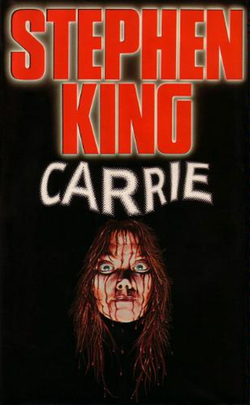 Bet $10 to attempt a story with a female main character by his friend, Flip Thompson, King started Carrie as a short story, but after a few pages (King has variously said four and 15) he realized that he had a novella on his hands. He reacted as most authors do to a novella: there’s no market for ‘em, so kill ‘em in the cradle before they get too big. His wife, Tabitha King, fished the first pages out of the garbage and insisted that he finish it.
Bet $10 to attempt a story with a female main character by his friend, Flip Thompson, King started Carrie as a short story, but after a few pages (King has variously said four and 15) he realized that he had a novella on his hands. He reacted as most authors do to a novella: there’s no market for ‘em, so kill ‘em in the cradle before they get too big. His wife, Tabitha King, fished the first pages out of the garbage and insisted that he finish it.
Fortunately for his financial future, the novella mutated into a novel and it sold for a $2,500 advance. The legend of Stephen King is that he was a blockbuster author right out of the gate. Not so much. Carrie sold less than 15,000 copies in hardcover. But the paperback rights were later sold for $400,000 and when it was released by New American Library as a mass market paperback one year later, it sold one million copies and changed King’s life for good.
The book itself moves in a rush (it’s King’s shortest book), beginning and ending in great big gushes of menstrual blood (Carrie does for menstruation what Portnoy’s Complaint had done for masturbation six years earlier). These days, Stephen King is famous for two things: writing horror books, and writing very, very long books. And while the dreamy images from Brian De Palma’s film adaptation have largely colonized my memory of Carrie (as have memories of Carrie the musical, which I unfortunately saw – don’t feel too bad, you’re not missing anything) it was a surprise to re-read the book and see how fuel-efficient it actually is.
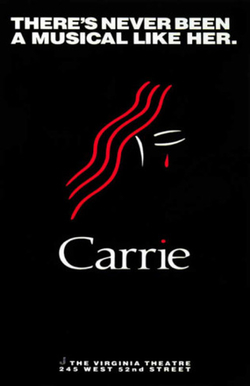 It’s this simple: Carrie White is a frugly teenager with a domineering, Bible-thumping, sex-hating mother and latent psychic powers. Her first period hits in the locker room showers and she doesn’t know what it is. Her classmates surround her, pelt her with tampons, and chant, “Plug it up! Plug it up!” As an act of atonement for participating in Carrie’s bullying, nice girl Sue Snell asks her boyfriend, Tommy, to take Carrie to the Spring Dance. As an act of revenge after being punished for bullying Carrie, mean girl Chris Hargensen plans to douse Carrie with pig’s blood at the Spring Dance. She’s assisted by her greaser boyfriend, Billy Nolan.
It’s this simple: Carrie White is a frugly teenager with a domineering, Bible-thumping, sex-hating mother and latent psychic powers. Her first period hits in the locker room showers and she doesn’t know what it is. Her classmates surround her, pelt her with tampons, and chant, “Plug it up! Plug it up!” As an act of atonement for participating in Carrie’s bullying, nice girl Sue Snell asks her boyfriend, Tommy, to take Carrie to the Spring Dance. As an act of revenge after being punished for bullying Carrie, mean girl Chris Hargensen plans to douse Carrie with pig’s blood at the Spring Dance. She’s assisted by her greaser boyfriend, Billy Nolan.
Everything in the book pretty much springs from Carrie’s first period: Sue’s guilt, Chris’s revenge plot, and the awakening of Carrie’s telekinetic powers. The night of the Spring Dance arrives, Carrie masters her telekinesis, stands up to her crazy mom, gets crowned homecoming queen, and has pig’s blood dumped on her in front of everyone. She freaks out and kills the entire town with her brain, finally bleeding to death from a knife wound inflicted by her Bible-thumping momma.
Compared to later books by King, Carrie is so short that it’s practically a haiku, but most of his stylistic trademarks are already present:
Quotations – Stephen King loves quoting poetry and song lyrics, and while Carrie features far fewer quotes than his later books (probably because the clearances department wasn’t willing to do too much heavy lifting for a then-unknown author) he still manages to get in fragments of Bob Dylan’s “Tombstone Blues” and “Just Like a Woman.”
Stream of Consciousness – Nothing says “Stephen King” like italicized stream of consciousness sentence fragments and run-on sentences that suddenly explode out of the middle of a paragraph. After some parenthetical asides in the beginning of Carrie, we get to page 20 and:
She looked back
(old bitch hates my momma)
over her shoulder.
It’s the first time he uses this device, but it’s certainly not the last. In the future, he’ll use it to the point of self-parody.
Multiple POVs – Not only is Carrie split between the points-of-view of Chris Hargensen, Sue Snell, Carrie White, her gym teacher, and her mother, but it’s also split between straight narrative, transcripts of hearings, excerpts from academic papers, eyewitness interviews, police reports, hospital admissions records, newspaper articles, and excerpts from Sue Snell’s fictitious memoir. It’s practically a collage novel. In later books, King will hopscotch around from one character’s skull to another, and he’ll often use a newspaper story or an excerpt from a magazine article to add some reality, but never again does he do it quite so much as he does in Carrie.
There’s also plenty of clumsy writing on display. In the opening shower scene, the girls are described as having “light and eager” morning sweat, whatever that is. Their gym teacher is described as being “their slim, nonbreasted gym teacher” which is a weird way to say she has small breasts. Throughout the book people make unreproducible sounds like “Ohuh” and when Carrie’s skirt rips at one point, it does so with “the sound of a huge wind-breakage.” Oh, you mean a fart? Even King isn’t a big fan. “I’m the first to admit that it is often clumsy and artless,” he said in a 1983 interview about Carrie. In another interview he praises De Palma’s film, claiming that the book is “too sobersided” and impeded by “a certain heaviness” whereas De Palma’s movie made it “frothy.”
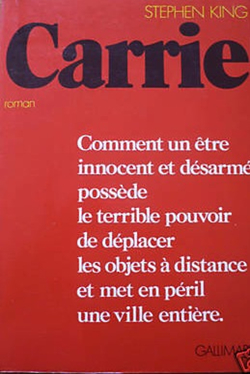 So why’d Carrie catch on? It hit shelves in 1974, a time when there was a fascination with teenagers that was not being served by popular culture. It was the year that the over-sexed teen jiggle comedy, The Cheerleaders, became an unexpected hit, and it’s easy to see why when you contrast it to what else was on movie screens. The majority of books and movies about teenagers hearkened back to a 1950’s pre-JFK-assassination era world of greasers and bobby soxers. American Grafitti and Lords of Flatbush were big hits (Billy Nolan, Chris’s boyfriend in Carrie, feels like a throwback to these 50’s greasers – ironically, he’d be played by the ultimate greaser throwback, John Travolta, in the film). The few movies that depicted contemporary teenagers were movies like 1969’s The Last Summer and 1971’s The Last Picture Show which were nihilistic, dead-end films that made underaged sex feel as cold and dour as sawing wood.
So why’d Carrie catch on? It hit shelves in 1974, a time when there was a fascination with teenagers that was not being served by popular culture. It was the year that the over-sexed teen jiggle comedy, The Cheerleaders, became an unexpected hit, and it’s easy to see why when you contrast it to what else was on movie screens. The majority of books and movies about teenagers hearkened back to a 1950’s pre-JFK-assassination era world of greasers and bobby soxers. American Grafitti and Lords of Flatbush were big hits (Billy Nolan, Chris’s boyfriend in Carrie, feels like a throwback to these 50’s greasers – ironically, he’d be played by the ultimate greaser throwback, John Travolta, in the film). The few movies that depicted contemporary teenagers were movies like 1969’s The Last Summer and 1971’s The Last Picture Show which were nihilistic, dead-end films that made underaged sex feel as cold and dour as sawing wood.
There was nothing dour about Carrie. It kicked off with a show stopper setpiece in the girl’s locker room, a voyeuristic, unforgettable scene that anticipated Porky’s by four years, and the sex just kept on coming. The first 50 pages alone featured endless of talk of “upthrust” teenaged breasts, Sue Snell making it with Tommy in his car (twice), one teenaged orgasm, Carrie massaging her own breasts in her bedroom almost to the point of masturbation, and topless teenaged sunbathing. To round it all off, King threw in a couple of bright green snot bubbles, a drunk with an enormous goiter on his neck, and lots of icky talk of bacne, pimples, and blackheads.
This was not what the readers of 1974 were used to finding in their books. Popular fiction in 1973 and ‘74 was a sawdust-flavored mixture of sober, high-minded doorstops by James Michener and Gore Vidal, leavened with glossy sex and sin bestsellers by Jacqueline Susann and Harold Robbins, with the occasional historical novel thrown in for fun. Science fiction was all hard SF novels of ideas like Arthur C. Clarke’s Rendezvous with Rama and Ursula K. Le Guin’s The Dispossessed. Horror fiction, however, did have a pulse, having received a recent infusion of respectability with the one-two-three of Rosemary’s Baby (1967), The Exorcist (1971), and Thomas Tryon’s double act of The Other (1971) and Harvest Home (1973).
But those books had pretensions to respectability. There was nothing respectable about Carrie, nothing high-minded. It wasn’t about upper middle class New Yorkers with good educations and nice clothes. It was raw, racy, and set firmly in a blue collar community. Full of tampons, religious mania, glow-in-the-dark Jesus paintings, boogers, teenaged boobs, and lots and lots of death, no one had read anything like it. As rough and raunchy as moonshine, it came slouching out of the wrong part of town, threw readers up against the bathroom stall, and yanked down their pants, offering a head-spinning mix of seedy thrills and tight, character-focused writing.
But King wasn’t just a character-writer, he had another narrative trick up his sleeve: he knew how to make the reader wait. And, as Wilkie Collins said, the recipe for a good book is “Make ‘em laugh, make ‘em cry, make ‘em wait.” From the first page of Carrie we know something really bad is going to happen at the Spring Dance because King reminds the reader on every other page that Something Really Bad Is Going to Happen at the Spring Dance. The more it’s hinted at, the more you want to see it, but King’s a showman, and he knows how to milk a moment.
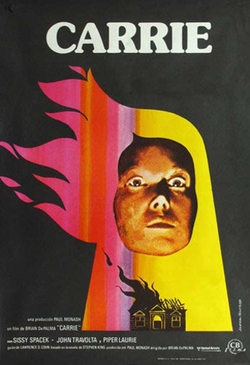 Right at the climax, the moment the book is building towards, King abandons Carrie’s point-of-view. We’re in her head right up until she gets crowned Queen, and then the pig’s blood comes down, and then…we get Billy and Chris Hargensen’s POV from outside the gym, we get a scene of Sue Snell making cocoa back home and hearing fire engines, we get an excerpt from a Reader’s Digest article about the prom night disaster, then Tommy’s POV as the falling bucket of blood knocks him unconscious and everything goes black, then wire items from the AP about the disaster, another Sue Snell scene as she races to the burning school, a transcript from an inquest about the prom night disaster, and only after all this do we rewind backwards and finally get released into Carrie’s head for the big pay-off.
Right at the climax, the moment the book is building towards, King abandons Carrie’s point-of-view. We’re in her head right up until she gets crowned Queen, and then the pig’s blood comes down, and then…we get Billy and Chris Hargensen’s POV from outside the gym, we get a scene of Sue Snell making cocoa back home and hearing fire engines, we get an excerpt from a Reader’s Digest article about the prom night disaster, then Tommy’s POV as the falling bucket of blood knocks him unconscious and everything goes black, then wire items from the AP about the disaster, another Sue Snell scene as she races to the burning school, a transcript from an inquest about the prom night disaster, and only after all this do we rewind backwards and finally get released into Carrie’s head for the big pay-off.
And it’s Carrie’s point-of-view that makes the book. Based on two actual students of his, King’s Carrie White is an example of character-based writing in motion. Carrie starts off seen from the outside, a big, dumb, ugly, zit-covered dork who’s so stupid she deserves to be humiliated. Then King gets inside her head and becomes deeply sympathetic to her plight, offering her a chance to reclaim her dignity. He’s ambivalent about her: he hates her (and probably his former students) for being weak, but he also wants to see them beat the bullies. But in real life the good guys don’t always win and just when all Carrie’s dreams seem to be coming true, hope is cruelly snatched away.
This is where King shifts gears and truly steers his book into Horrorville. When Carrie uses her telekinesis to fight back, her word choice, rhythm, and diction transform into those of her hated mother, the most gothic and horrific character in the book. For the entire book she’s fought against her mother, resisting her influence, but when Carrie’s mind snaps you see her morph into her mother right there in the paragraph break. The characters aren’t aware of what’s happened, but it’s all too obvious to the reader: Carrie has turned into the woman she hates more than anyone in the world. And so Carrie dies with her most horrifying fear coming true: she grows up to be just like momma.
Grady Hendrix has written about pop culture for rags ranging from Playboy to World Literature Today. He also writes books! You can follow every little move he makes over at his blog.










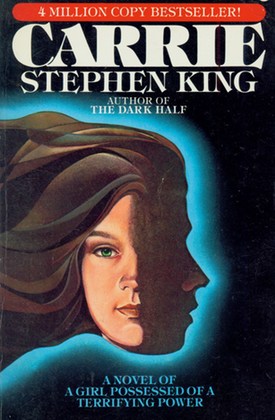
I read Carrie in High School. I’m 49 now. That paperback was passed around to at least 4 or 5 other friends of mine in school. I still have it somewhere. But, King’s narrative drove that book. I’m a male, and I was not the most popular guy in school. I was the guy that pretty girls came to for advice on their jock boyfriends. So, even though Carrie is a girl, I related to her in a very big way. I was the leftout and the loner. People relate to Carrie because she is who she is, we all wish (in some dark corner of our hearts) that we could make those “popular” kids that we knew back in school feel how we felt. Carrie let it all go and it was horrible. But, you could not help but cry for her. Cause, in a way, we were all feeling used up like that.
I’ve heard so much about this book over the years, but never read more than the first few pages and never read the movie, because horror really really isn’t my thing. Thanks for putting the plot down succinctly here, so now I know what the story was even if I’m still not eager to endure a reading or showing!
My biggest complaint with Carrie is that is started King off on a path of featuring Christian sociopaths/psychopaths. Over his career I can recall many Christian zealots whose beliefs are, frankly, crazy, non-mainstream, and decidely poisonous, but very few positive Christian characters and no psychopathic zealots of other faiths. Maybe it was startlingly new in 1974, I can’t say. But by now it is just lazy and offensive.
@3 – You might find this article interesting:
http://religion.blogs.cnn.com/2012/06/02/the-gospel-of-stephen-king
Is it more important that a character proclaim that he or she is Christian or that he or she think and act in a Christian manner?
I also read Carrie right after it came out when I was thirteen. I read a lot and what I noticed immediately was how different the structure of the book was (different p.o.v., newspaper articles etc). I loved it and to this day try to read everything Mr. King has written (not always easy to find).
I recommend his sons and wife’s books as well.
Not sure how I feel about the new movie because I consider the original a classic.
#3 Try Mother Abigail, et al. in The Stand.
I still clearly remember my junior year in high school, I worked in the library, a real treat for someone like me. It was there I found the hardcover of Carrie, and with little fore knowledge took the book home and consumed it in like two days.
It made me a real King fan right through the mid 80s, but the book bloat eventually drive me away. however, Carrie remains in my mind as a stellar example of what horror can be.
I for one, look forward to the remake as I was underwhelmed by the orginial film.
If I had to pick one of Stephen King’s earlier works to call a classic, it would be ‘Salem’s Lot. That book brought the vampire tale into modern times, with an extra cream filling of evil-in-small-towns.
I realize this part doesn’t have much to do with Carrie, but it still bugs me a bit:
“Science fiction [in 1973-74] was all hard SF novels of ideas like Arthur C. Clarke’s Rendezvous with Rama and Ursula K. Le Guin’s The Dispossessed. Horror fiction, however, did have a pulse…”
Those two novels don’t resemble each other in any way, and not many people would call the former a “novel of ideas” or the latter “hard SF”. That description is so odd that it’s unclear what the point is supposed to be; even if they were at all similar, it seems like they’re being used as examples because they won Hugos, which doesn’t mean the majority of popular SF at the time was like those two (any more than most movies are similar to Oscar winners). And the contrast with “…did have a pulse…” makes it sound like the SF of the time was dead, boring, or sexually uptight, which really wasn’t the case.
@3 King has written plenty of non-religious crazy people, and plenty of decent people who are Christian. You’re probably not remembering them as readily because the crazy zealot mom type (whether religious or just generally paranoid) is kind of a stock character for him– that is, he tends to write those as very similar to each other, whereas his other villains and non-villains have more variety (except maybe for the abusive husbands, who also tend to read predictably to me).
I wouldn’t be surprised if there was some particular person like that who made a big impression on him early on; his mom wasn’t, as far as I know, but there’s a kind of oversized icky horror to the way he writes them that makes it seem more like something he had some personal fear of. Or maybe I just think that because I’ve also read a lot of Ramsey Campbell, who does something very similar and has stated that it’s absolutely for that reason.
As for “no psychopathic zealots of other faiths”– he doesn’t write a lot about non-Christian religions, period. He comes from New England Methodists and tends to write what he knows; even Catholicism is somewhat exotic to him.
Hey Elibishop – just wanted to chime in and say that you’re right that the two books aren’t the same, but they are both more novels of ideas than books driven by character or plot. That might be my personal prejudice, but LeGuin’s sci-fi always seems to have long pages of people explaining theories and concepts to each other, and Clarke’s book is really about the mysteries of Rama, more than anything else, and the exploration of it is just a lens through which we can ponder its majesty.
My bigger point, and I may have made it badly, was that the sci-fi that was getting attention and awards at the time was more about ideas and concepts than anything much resembling real people dealing with real problems. I like The Man Who Folded Himself, and The Dispossessed, but to me they seem to be about ideas and concepts, rather than human behavior.
By contrast, Rosemary’s Baby was about a woman coping with her pregnancy, The Other was about the relationship between twins, and The Exorcist is, at heart, about a mother and her sick daughter. It’s a far cry from where science fiction in general seemed to be, although I’m sure there are exceptions (JG Ballard’s Crash is one that springs to mind).
Nice re-read. (I had the edition that the first cover photo is taken from.)
What struck me about Carrie (as opposed to King’s later works) is that King hadn’t figured out what kind of author he wanted to be. This read like a horor novel written by a science fiction author.
Yes, I always thought King’s greatest strength was answering the question “what would a real person do if?”, but at this point in his carreer, he was torn between the two genres. Given his strenghths, I think he chose well. But it might have been interesting to see what he would have done if he went the other way.
I’m always kind of surprised that I missed this book because I was horribly bullied as a pre-teen/teen and was pretty much obsessed with gory slasher films and dark comedies in which teenagers kill each other (Heathers, Drop Dead Gorgeous, Jawbreaker, etc). Even though I never saw the movie or read the book, I loved the idea, haha. Actually, high school is when Things Got Better for me (and as corny as it sounds, my mom taking me to see Star Wars at the local ‘cheap theater’ is what got me off all the super gory movies I was in to and gave me something a little more positive to obsess about – there were other factors too – good support system in my family, a positive relationship with my religious faith, etc – but that was definitely part of it), but I remember middle school as awful, awful, awful.
What exactly do you mean by this: “a big, dumb, ugly, zit-covered dork who’s so stupid she deserves to be humiliated.” I didn’t realize there was an acceptable threshhold for bullying.
@14 You left off the beginning of that sentence: “Carrie starts off seen from the outside”– in other words, that’s the point of view of the other girls.
It was my understanding that the two girls that King based Carrie on were girls that he went to school with, not former students of his.
@@@@@LisaMarie…he isn’t saying that there is an “acceptable threshhold for bullying”. He is showing that in the context of Carrie and other stories that deal with bullying, bullies tend to find reasons to justify their actions. We know that Carrie doesn’t deserve to be bullied…no one does. But the perception of her as ugly and weird, essentially a loser, is what motivates people to mistreat her. It is easier to bully somebody who seems weak and has no friends to defend them.
This is why bullying is so harmful, because the bully strips the victim of their humanity. Carrie is less than human to them because she is on the very bottom of the totem pole. Sue Snell is the only one with a conscience and she reaches out to Carrie as a show of remorse. Like you, I was also bullied severely from the age of 4 until college. When I first read “Carrie” and saw the movie, I could identify with her. My mother wasn’t some batshit crazy religious nut, but I grew up in a broken home nonetheless. My stepfather was the abusive one. So between bullying at school and verbal/emotional abuse at home, I felt isolated.
I guess this is part of why I love Stephen King’s work…he delves into the dark side of humanity and explores the parts of our psyches that we prefer to remain hidden. And yes, @@@@@ ManWithPez, that is correct. Carrie was based on two classmates King had in high school in rural Maine. He described one of them as coming from a poor family, being very shy and awkward, and wearing the same clothes on a daily basis. But one day she came to school in a seemingly new outfit and instead of accepting her, the other kids picked on her even more. She killed herself about 10 years later.
The other girl was obese, had problems with hygiene, and had a mother who was obsessed with lottery/sweepstakes. This girl was also bullied terribly. So I believe in his own way, King is showing how cruel people can be and he isn’t simply telling good stories…he is encouraging us to be kinder to one another or at the very least, giving us characters we can relate to.
Excellent review, I just found this site and I’m going to check it all out. You skipped a few King books, particularly from the 1980s. How come?
By the way, just to be an annoying worthless trivia junkie, “The Last Picture Show” wasn’t about contemporary teenagers. It takes place in the early 1950s, so it goes along with “Graffiti” etc. except that it wasn’t nostalgic. Just realistic.
“There was nothing respectable about Carrie, nothing high-minded. It wasn’t about upper middle class New Yorkers with good educations and nice clothes. It was raw, racy, and set firmly in a blue collar community. Full of tampons, religious mania, glow-in-the-dark Jesus paintings, boogers, teenaged boobs, and lots and lots of death, no one had read anything like it. As rough and raunchy as moonshine, it came slouching out of the wrong part of town, threw readers up against the bathroom stall, and yanked down their pants, offering a head-spinning mix of seedy thrills and tight, character-focused writing.”
Single best explanation of what set King apart I’ve ever read. Period.
Nice analysis on why Carrie catch on. Just a couple of punctualizations, King didn’t base Carrie on two students, he based her on two girls who went to his school when he was a student. Also, he wasn’t still living in a trailer when Carrie was purchased, he had already moved to a small apartment.